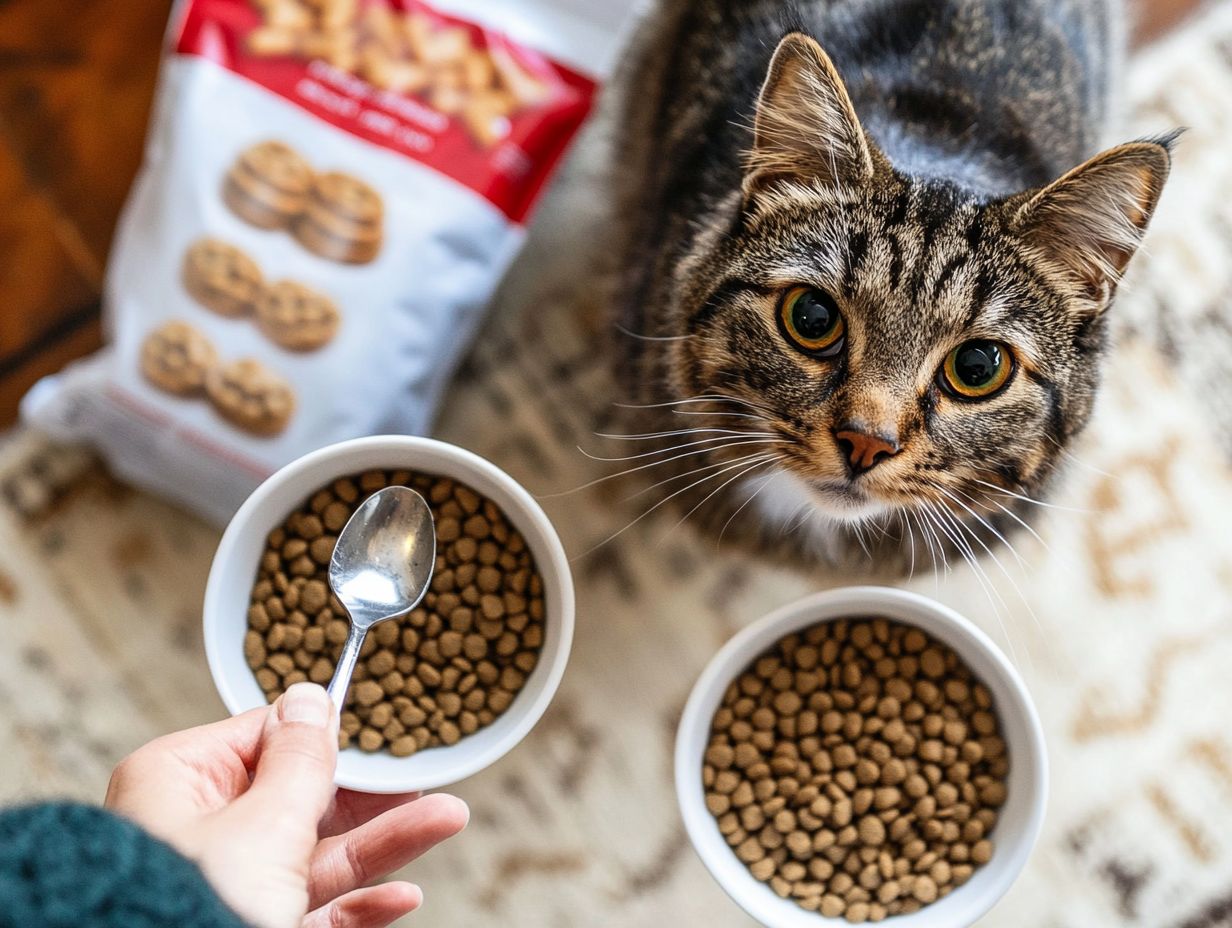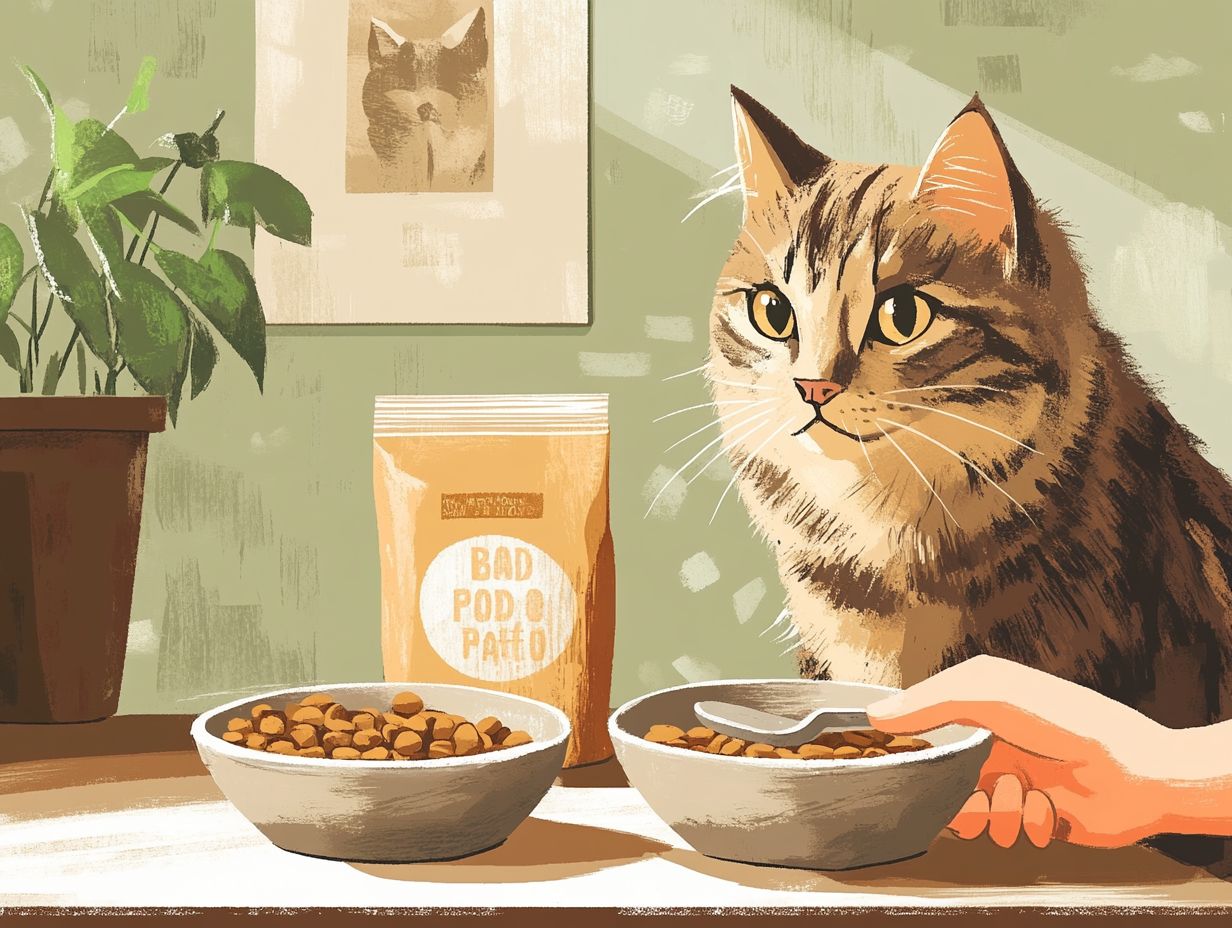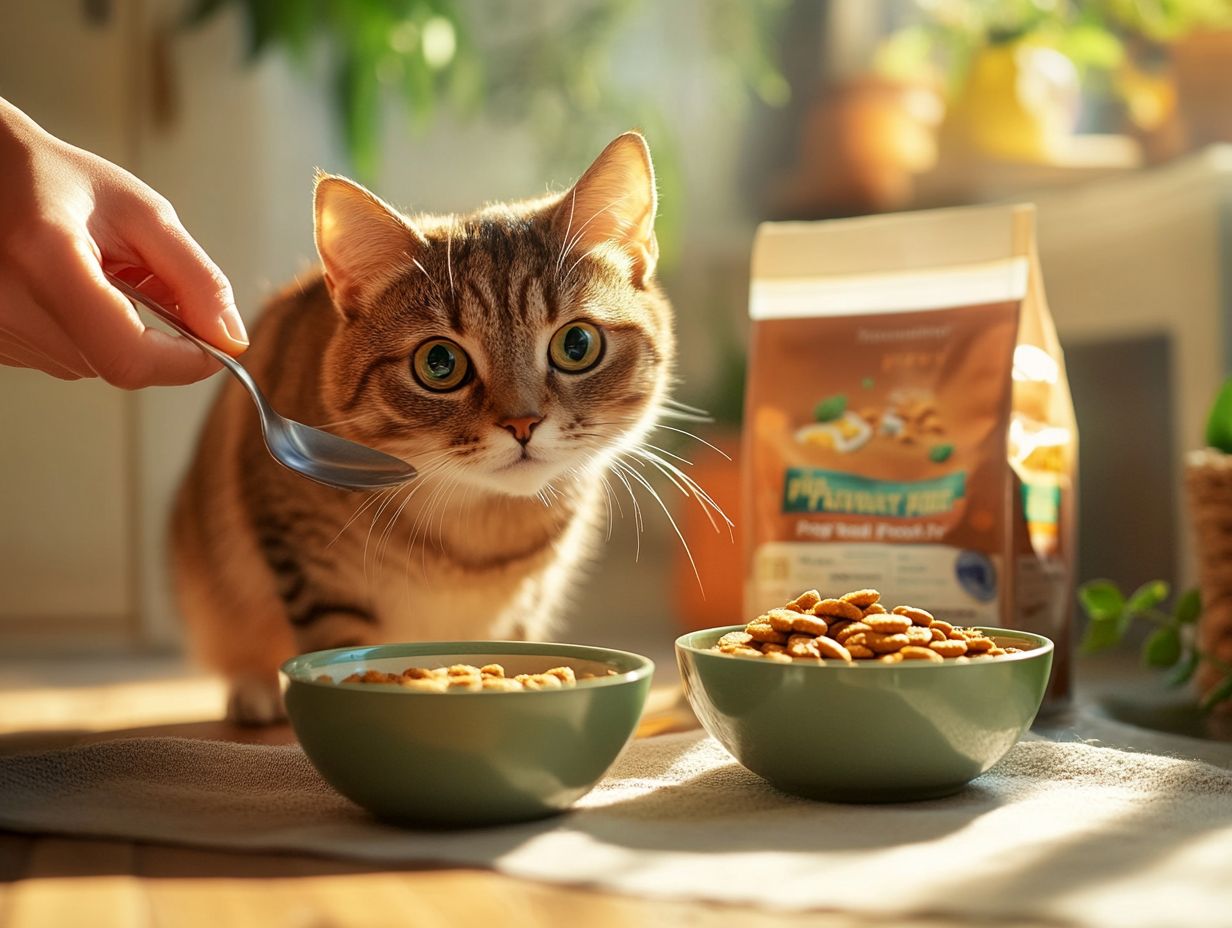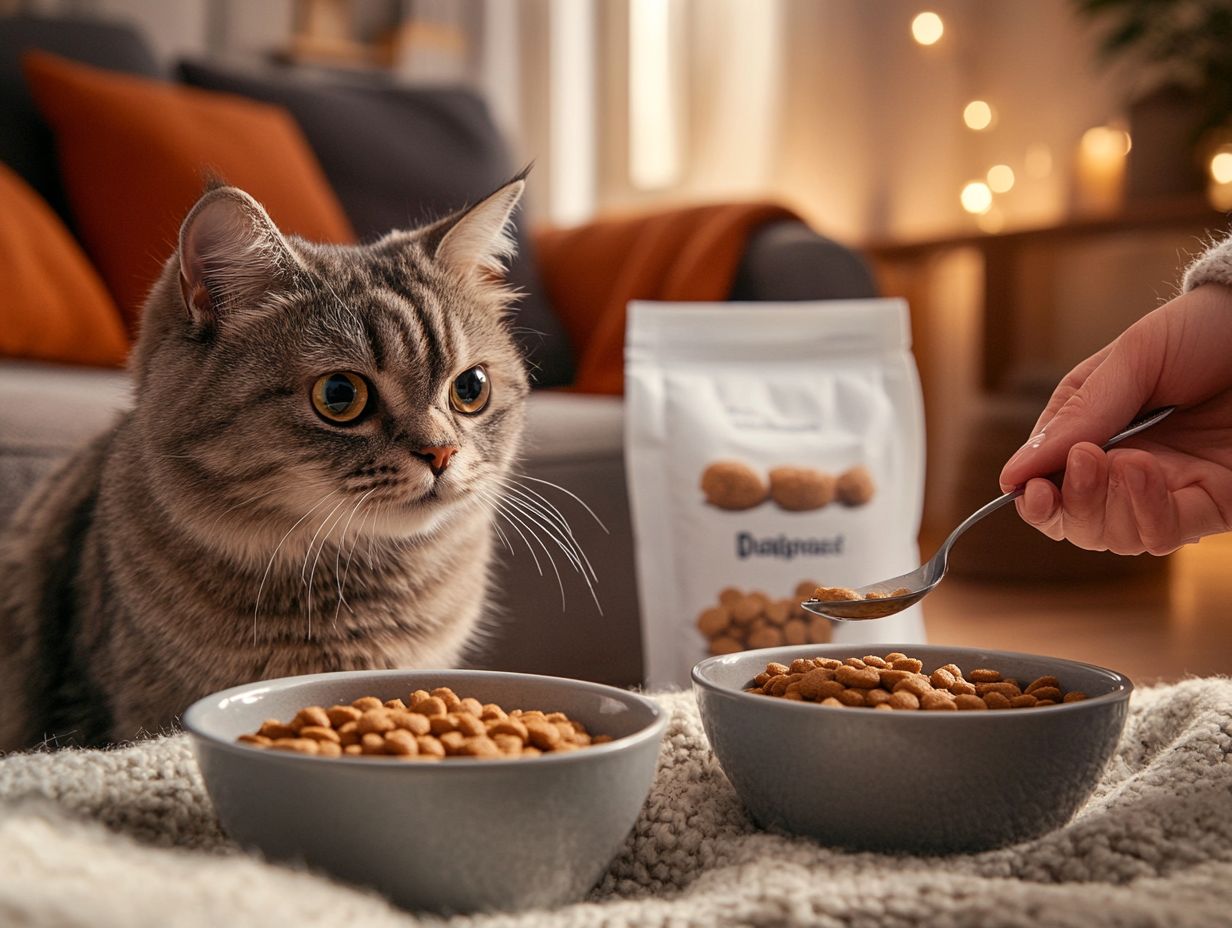Disclaimer: The information provided in this article is for educational purposes only and should not replace professional veterinary advice. Always consult your veterinarian regarding your pet’s specific dietary needs.
Navigating your cat’s health can be challenging, especially regarding their diet. Prescription cat food offers specialized nutrition designed to address specific health issues, making it important to understand its necessity and benefits, as guided by current veterinary nutrition standards and AAFCO and WSAVA guidelines.
This article explores prescription cat food, including when it’s needed, how to transition your cat smoothly, and what to do if they refuse to eat it. Understanding the right feeding guide and schedule meals can assist in making the process easier.
You will also learn how to ensure they’re getting the nutrition they need.
Dive in to make informed choices for your beloved pet!
Key Takeaways:

What is Prescription Cat Food?
Veterinarian-prescribed cat food is specifically formulated to address particular health conditions in cats, as recommended by a veterinarian. These specialized diets often include unique ingredients tailored to meet the nutritional needs of cats with specific health issues, such as food allergies, gastrointestinal diseases, or liver damage.
They are designed to provide a balanced nutrition that helps alleviate symptoms and promote overall wellness in pets.
Why Would a Cat Need Prescription Food?
Cats may require prescription food for various health conditions that impact their well-being and quality of life. These conditions can include food allergies, gastrointestinal issues, and other health problems that necessitate diets specifically formulated to provide the appropriate nutritional profile.
Such diets are designed to assist in the treatment and management of symptoms, as recommended by a veterinarian.
What Health Conditions Require Prescription Cat Food?
Illnesses that necessitate prescription cat food include food allergies, gastrointestinal diseases, and various sensitivities. Many of these cases require specialized diets to appropriately manage the specific nutritional needs of affected pets. Consulting the Association of American Feed Control Officials guidelines ensures food quality and nutritional balance.
For food allergies, which often lead to skin irritations and gastrointestinal issues, prescription cat food may include hypoallergenic formulas, meaning they contain ingredients less likely to trigger allergic reactions. In the case of diabetes, prescription cat foods are essential for controlling carbohydrate intake and providing low-glycemic diets, crucial for maintaining stable blood sugar levels.
For kidney disease, prescription cat diets are specifically formulated to reduce protein, phosphorus, and sodium intake, thereby decreasing the workload on the kidneys. Veterinarians select these specialized diets based on each patient’s unique medical needs and circumstances.
Commercial vs. Homemade Prescription Diets
It is essential to understand the differences between commercial prescription diets and homemade diets. While commercial diets are formulated to meet specific nutritional standards, homemade diets carry potential risks if not properly balanced. Always consult your veterinarian before choosing a homemade diet to ensure it meets your cat’s specific needs.
How to Transition Your Cat to Prescription Food?
Transitioning your cat to prescription food can be straightforward if done gradually. Start by mixing the new food with their current food, slowly increasing the proportion of prescription food over several days. Monitor your cat for any signs of distress or adverse reactions.
How to Store Prescription Cat Food
To maintain the quality and safety of prescription cat food, store it in a cool, dry place and tightly seal the packaging. Check for any signs of spoilage, such as off-smells or changes in texture, before feeding.
What Are the Benefits of Prescription Cat Food?
Prescription cat food offers several benefits by providing specialized nutrition that helps manage the clinical signs associated with various illnesses. These foods are specifically formulated to ensure a nutritional profile that supports the management of health issues while promoting optimal wellness and quality of life for pets.
By consulting with veterinarians, pet owners can leverage the specialized knowledge of these professionals to select the best food for their cats. Prescription cat food diets can effectively manage conditions such as diabetes, kidney disease, and obesity. These diets often include specialized ingredients designed to improve diabetes management, renal function, and weight loss goals.
Additionally, prescription cat diets frequently contain added antioxidants and Omega fatty acids, which support immune function and joint health, respectively. This approach ensures that a cat’s diet not only addresses existing health problems but also plays a preventative role, highlighting the close relationship between diet and the overall health of cats.
Special Dietary Needs for Different Life Stages
Kittens, senior cats, and pregnant or nursing cats have unique nutritional requirements. Ensure that their diets are tailored to their life stage to support their health and development. Consult your veterinarian for recommendations on suitable diets for each stage.
Regular Veterinary Check-ups
Emphasizing the significance of regular veterinary check-ups is crucial to assess the effectiveness of the prescribed diet and make adjustments as necessary. Regular visits can help ensure your cat is thriving on their new diet.
In summary, understanding prescription cat food is essential for managing your cat’s health. With proper guidance, you can make informed choices that benefit your beloved pet.
Transitioning your cat to prescription food is a carefully controlled transition process designed to help your cat adjust to the new diet with minimal digestive upset. Consulting veterinary guidelines from AAFCO and WSAVA can reinforce the scientific validity of this process.
This process typically involves blending the new food with your cat’s current diet in a way that addresses their specific dietary needs and health conditions, such as chronic kidney disease or diabetes, often following the guidance of a veterinarian.
1. Consult with Your Veterinarian

Consulting your veterinarian is the first and most crucial step in transitioning your cat to prescription food. Veterinarians are trained to understand your cat’s unique health needs and can recommend dietary changes accordingly. This vet consultation ensures that all nutritional requirements are met, reinforcing the need for high-quality animal protein in prescription diets, which aligns with the obligate carnivore nature of cats.
A consultation ensures that the food you provide is suitable for your cat’s specific health conditions and nutritional requirements. They have the expertise to assess various factors such as age, weight, and existing medical issues, enabling them to create a tailored plan that prioritizes your cat’s health.
This may include strategies for weight loss, management of kidney disease, or avoidance of allergens. By identifying high-quality prescription foods designed to meet specific dietary needs, veterinarians enhance the effectiveness of these dietary changes.
Additionally, they will follow up regularly to monitor your cat’s response to the new diet and make any necessary dietary adjustments based on their current health status. Keeping a diary of your cat’s reactions during the transition can help facilitate discussions with your veterinarian.
2. Gradually Introduce the New Food
The best way to help your cat adjust to new food is to gradually introduce the prescription diet over several days or weeks, minimizing any potential digestive upset. This gradual transition allows the cat’s digestive system to adapt while enabling the owner to closely monitor the animal’s health for any adverse reactions, such as soft stools or changes in appetite.
Start the transition by mixing a small amount of the new food with the current food, aiming for approximately 10 to 20 percent of the total meal. Over the next three to seven days, gradually increase the portion of the new food while decreasing the old food, with the objective of achieving a 50-50 ratio by the end of the week. This transition schedule should be tailored to your cat’s specific diet.
It is important to observe your pet’s reactions during this period; any signs of discomfort or unusual behavior may indicate the need to slow down the transition. Additionally, monitoring their litter box habits and energy levels can provide valuable insights into how well your cat is adapting to the new diet. Regular follow-ups with the veterinarian during the transition are also recommended to assess both physical health and any behavioral changes, which can indicate stress or discomfort with the new diet.
3. Mix the Old and New Food Together
Mixing old food with new prescription food is an effective strategy to ensure a smooth transition for your cat. This approach allows your pet to gradually adjust to new flavors and textures while ensuring they receive adequate nutrition. Following a structured transition schedule can also help assess how well your cat is accepting the new diet.
To begin, introduce the new food at a ratio of 25% new food to 75% old food for the first few days. Gradually adjust this ratio every few days based on your cat’s adaptation to the new diet, increasing the new food to 50%, then 75%, and eventually 100%. Consider using a tablespoon new for precise measurement during this process.
It is crucial to monitor your cat’s eating habits, stool consistency, and overall well-being during this transition period. If any gastrointestinal issues arise, such as vomiting or diarrhea, be prepared to modify the transition ratio. Additionally, any concerns about allergens or specific ingredients in prescription diets should be discussed with a veterinarian. By following this method, you can facilitate a smooth transition, leading to a more enjoyable mealtime experience for your cat.
4. Monitor Your Cat’s Response
Monitoring your cat’s response is crucial for ensuring a successful transition to prescription food and for confirming that your cat is adjusting well to the new diet. Be vigilant for signs of digestive upset and behavioral changes, and don’t hesitate to contact your veterinarian with any concerns.
It’s important to watch for potential adverse effects such as vomiting or diarrhea, as well as changes in energy levels, appetite, and overall disposition. Cats can be sensitive to dietary changes, so any signs of discomfort, like lethargy or aggression, should be carefully noted. Continuous monitoring of pet wellness is essential during this phase. Also, remember that weight management is essential, especially during transitions; consider monitoring your cat’s body condition score to help identify any necessary adjustments to feeding practices.
Regular weigh-ins can help determine whether the new diet is meeting your cat’s nutritional needs. Maintaining open communication with your veterinarian is essential, as they can provide tailored recommendations and monitor your cat’s progress, ensuring that any new health issues are addressed promptly.
What to Do if Your Cat Refuses to Eat Prescription Food?
When a cat refuses to eat prescription food, it can hinder progress in addressing their specific health needs, requiring alternative strategies to encourage acceptance. Trying canned food or new flavors might help in overcoming food sensitivities. It is crucial to consult with a veterinarian for guidance, especially if your cat has underlying health conditions.
By understanding the factors that contribute to this behavior, such as taste or texture, pet owners can develop effective methods to ensure their cat receives the necessary nutrition.
1. Try Different Flavors and Textures
Experimenting with various flavors and textures of prescription food can enhance a cat’s acceptance and willingness to eat. Cats have specific biological preferences that can influence their appetites. Some cats prefer rich, savory flavors, while others favor lighter or more delicate tastes. Offering new flavors can help accommodate these preferences and improve dietary satisfaction.
Texture is also important; some cats prefer soft, pâté-style foods, while others do better with chunky or shredded varieties. Customizing their feeding experience by including a gradual process of introducing different textures can lead to greater enjoyment and improve overall health and nutrition.
Offering a range of tastes and textures can contribute to a more balanced diet and may help reduce pickiness at mealtime. However, it’s essential to be cautious and consult with a veterinarian, especially for cats with specific health conditions like kidney disease or diabetes, as their dietary needs may differ significantly.
2. Add Some of the Old Food to the New

Incorporating some of your cat’s old food into the new prescription diet can help ease the transition and entice your cat to eat by introducing familiar flavors alongside the new ones. This method is particularly beneficial for maintaining a consistent feeding schedule and ensuring a successful dietary change by reducing food sensitivities.
- To start, mix a small portion of the current food (25%) with the new prescription diet (75%) for the first few days. This gradual introduction allows your cat to become accustomed to the new taste and texture without overwhelming them, minimizing digestive upset.
- After about a week, if your cat is adjusting well, you can increase the ratio to 50% of each food.
During this period, closely monitor your cat’s appetite and behavior for any signs of dietary distress, such as vomiting or diarrhea. Then, gradually transition to a 100% new diet over the course of two weeks. Maintaining consistent feeding times will also help support your cat’s digestive health.
3. Make the Transition Gradual
The transition to prescription food for cats should be a gradual process to prevent stress or discomfort in the animal’s digestive system. A slow transition minimizes the chances of digestive upset and helps maintain the cat’s interest in the new food, ensuring a successful diet.
This approach allows caregivers to monitor for any adverse reactions and make adjustments if necessary. Introducing small amounts of the new prescription food into the cat’s regular diet creates a more comfortable transition environment.
Over time, this method helps the cat build confidence and security in its surroundings, facilitating better acceptance of the new diet. Ultimately, this gradual transition positively impacts the cat’s overall health by ensuring that essential nutrients are properly absorbed and that specific health conditions are effectively managed.
4. Seek Advice from Your Veterinarian
If your cat refuses to eat prescription food in the long term, consulting your veterinarian can provide valuable advice and food recommendations tailored to your cat’s specific needs. A veterinarian will assess your cat’s overall health and suggest alternative options that may be more palatable than prescription food. They can also guide you on proper food storage and handling practices, including how to identify spoilage.
Life Stage Considerations
When transitioning diets, it’s essential to consider your cat’s life stage; dietary needs may vary for kittens, senior cats, and pregnant or nursing cats. Adjust feeding advice accordingly to ensure that all essential nutrients are provided based on their specific life stage.
Dietary issues can be complex for pet owners, who often feel overwhelmed by the challenge of ensuring their cats receive the right nutrients to maintain their health. However, this confusion can be alleviated by seeking guidance from a veterinarian, who can clarify what is necessary and why, while considering your cat’s unique health conditions. Always consult your veterinarian for personalized dietary advice, especially for cats with specific health concerns.
Veterinary advice is crucial to determine if your cat has any allergies, sensitivities, or preferences that should be considered when establishing the best diet. With the right guidance, feeding problems can be resolved more efficiently and effectively.
How to Ensure Your Cat is Getting Proper Nutrition?
Ensuring your cat receives proper nutrition is essential for their overall health and well-being, especially during dietary changes. This involves carefully reading the ingredient list and guaranteed analysis of cat food products to confirm that they meet the nutritional and dietary requirements recommended by veterinarians and aligned with AAFCO and WSAVA standards. This is particularly important for specific health issues, such as food allergies or gastrointestinal issues.
1. Read the Ingredient List
The ingredient list of cat food is one of the most important factors to consider when ensuring that the food meets a cat’s nutritional needs, especially when selecting a specific diet or prescription diet. Look for specific animal-based proteins, such as chicken, beef, or fish, listed among the first few ingredients, as these should constitute a significant portion of a cat’s dietary intake.
This list provides owners with insight into the actual quality of the ingredients and their suitability for addressing a cat’s specific health condition or pet health requirements. Additionally, the absence of vague terms like “meat by-products” and artificial additives serves as a good indicator of a higher quality product. For those selecting food for cats with health issues, omega fatty acids, such as omega-3 fatty acids, can benefit skin conditions, while probiotics can support digestion.
Therefore, understanding the nutritional value of each ingredient is crucial to ensure that the food both satisfies appetites and nourishes the body.
2. Check the Guaranteed Analysis
The guaranteed analysis found on cat food packaging provides essential information about the nutritional balance, including protein, fat, and fiber content, necessary for meeting your cat’s dietary needs. Evaluating this analysis helps ensure that the food aligns with the veterinary recommendation given by your veterinarian.
Understanding these components is crucial, especially since felines have specific nutritional requirements that can vary based on their age, health status, and lifestyle. Protein is particularly important for muscle maintenance and overall energy, while essential fatty acids contribute to skin and coat health. Fiber plays a key role in digestive health and aids in the prevention of hairballs and constipation, while managing gastrointestinal diseases.
By carefully assessing this information, pet owners can make informed choices that not only meet the basic dietary requirements but also promote the overall well-being of their furry companions, in accordance with appropriate veterinary advice and dietary guidelines.
3. Monitor Your Cat’s Weight and Overall Health

Monitoring your cat’s weight and overall health is essential for ensuring they are properly fed, especially during dietary changes. Regularly checking their weight and observing any noticeable changes in behavior or health can provide valuable insights into whether their current food meets their dietary needs, including specific nutritional needs.
- Weigh your cat at least once a month, or more frequently if they are at risk for specific health issues.
- Watch for subtle signs such as poor appetite, lack of energy, or an unkempt coat that may indicate potential health problems.
- Consult your veterinarian for a nutrition consultation if you notice any concerning symptoms.
Additionally, establishing regular feeding times is important; feeding your cat at the same times each day can help regulate their metabolism and weight. Discuss suitable dietary options with your veterinarian, who can help ensure that the diet you choose is appropriate for your cat’s age, lifestyle, and health status.
Potential Risks of Various Diets
It is essential to understand the potential risks associated with various diets, such as:
- Raw diets may pose risks of bacterial contamination and nutritional imbalances.
- Vegan diets are not typically suitable for obligate carnivores like cats and may lead to deficiencies.
- Homemade diets can lack essential nutrients unless carefully formulated under veterinary guidance.
Always consult with your veterinarian to ensure any diet aligns with your cat’s health needs.
Special Dietary Needs for Specific Health Conditions
Cats with specific health conditions such as kidney disease or diabetes require tailored dietary plans. Consult a veterinarian for guidance on how to best manage your cat’s nutrition based on their health status.
Food Storage and Handling
Proper food storage and handling are crucial to prevent spoilage and foodborne illnesses. Here are some tips:
- Store cat food in a cool, dry place, and seal it tightly to maintain freshness.
- Check the expiration date regularly and discard expired food.
- Avoid leaving wet food out for more than 30 minutes to minimize spoilage.
Discuss any supplements or additives with your veterinarian to ensure their safety and efficacy based on appropriate dosages.
4. Talk to Your Veterinarian Regularly
Regular consultations with your veterinarian are essential for maintaining your cat’s dietary health and for making necessary adjustments to their nutrition plan. By discussing dietary guidelines and any concerns you may have regarding your pet’s health, as advised by the veterinarian, you can facilitate prompt interventions and modifications to their prescribed diet, ensuring they receive a balanced diet that meets your cat’s specific nutritional needs.
Frequently Asked Questions
How do I know if my cat needs to switch to prescription cat food?
If your cat has been diagnosed with a health condition that requires a specific diet, your veterinarian may recommend switching to prescription cat food. This can include conditions such as kidney disease, food allergies, or weight management issues. Additionally, observe symptoms such as lethargy, changes in eating habits, or unusual behavior, which may warrant a dietary review with your veterinarian.
What are the benefits of switching to prescription cat food?
Prescription cat food is specifically formulated to support and manage specific health conditions in cats based on current AAFCO standards. This can include ingredients that are easier to digest, lower in certain nutrients, or have a specific nutrient ratio to support your cat’s health needs, as recommended by the Association of American Feed Control Officials.
How do I transition my cat to prescription cat food?
It is important to transition your cat slowly to avoid any digestive upset. Start by mixing a tablespoon new prescription cat food with your cat’s current food, gradually increasing the amount of prescription food over a period of 7-10 days until your cat is only eating the new food. Monitoring your cat’s response during this period is crucial to address any dietary sensitivities or allergies.
How long does it take for my cat to adjust to the new food?
Every cat is different, but it can take up to 4-6 weeks for your cat to fully adjust to the new food. During this time, monitor your cat’s appetite, stool, and overall health to ensure they are tolerating the new food well. Keeping a feeding diary to track any changes in behavior or health can be helpful during veterinary consultations.
Are there any potential side effects of switching to prescription cat food?
Some cats may experience temporary digestive disturbances when transitioning to a new food, such as diarrhea or vomiting. This usually resolves within a few days, but if your cat continues to have issues, consult with your veterinarian.
Can I mix prescription cat food with my cat’s current food?
It is best to avoid mixing prescription cat food with other types of food, as this can lead to nutrient imbalances and may not provide the therapeutic benefits intended by the prescription diet. If your cat has multiple health concerns, such as gastrointestinal issues or liver damage, speak with your veterinarian about the best course of action for their diet.
For personalized dietary advice, always consult with your veterinarian to ensure the best care for your cat.